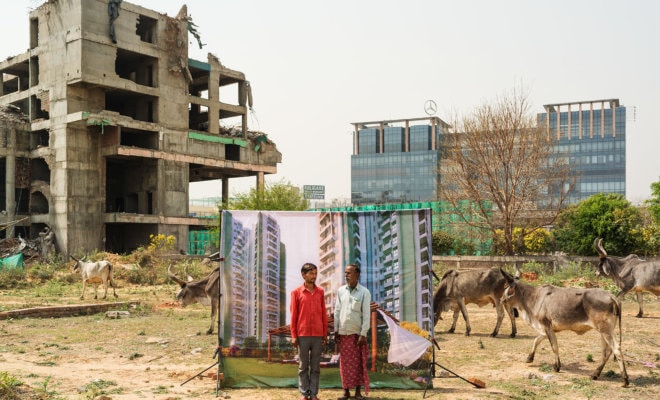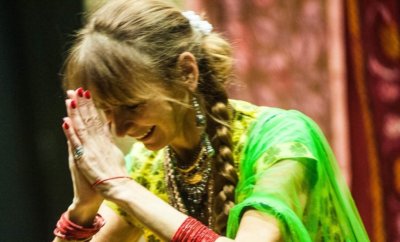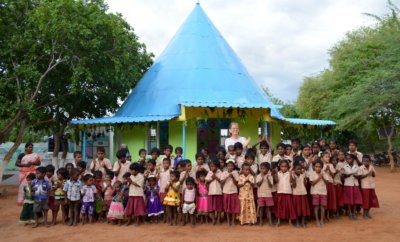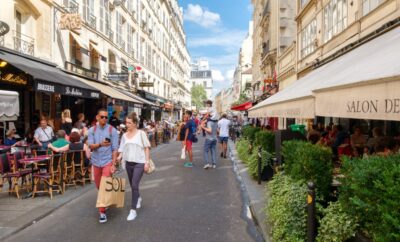Arts
Topping the Billboards

An image from Arthur Crestani's Bad City Dreams.
Photo: Arthur Crestani
French photographer Arthur Crestani’s series on Delhi’s rapid urbanization presents a paradoxical picture of the development in and around the city.
It was a long bicycle ride during which French photographer Arthur Crestani, then a student of political science at Jawaharlal Nehru University in New Delhi, noticed the rampant expansion in the city, panning out to the National Capital Region (NCR). Capturing the visuals at these construction sites later through his lenses made Crestani see what was beyond the glamorous, inviting billboards.
“I would wander off to far off places in Delhi and the NCR area,” the Paris-based photographer tells Little India. “It was at one such adventure that drove my attention towards these appealing signboards of properties in Gurugram. These were real head turners.”
Crestani first came to Delhi in 2010 as an exchange student. The Indian culture and Delhi, in particular, fascinated him. “After completing my masters degree in France, I returned to India in the summer of 2012. By the following year I had become quite familiar with Delhi and also managed to learn a bit of Hindi,” he recalls.
He went back to France to pursue a course in photography in 2014 and returned to India this year to photograph one of his favorite cities — Delhi — for his project, Bad City Dreams.
In this series, Crestani fuses elements of place and images to form a layered portrait of the rampant expansion in the periphery of the Indian capital. The set of 20 photographs, he says, presents a paradoxical picture of the development in and around the city.

An image from Bad City Dreams. Photo: Arthur Crestani
The heroes of his series are not just the visual elements, but also the migrant workers and security guards who posed for his pictures. “I would go up to them and ask them to pose for me in front of these boards and they were more than happy to do so. Later, I shared these pictures with many of these workers,” Crestani says. Some of them even gave their inputs regarding their pictures. “Many would ask me to send some more photos,” Crestani adds.
What really impressed the 27-year-old photographer were the pictures that these boards had on display. “These pictures made tall promises about the amenities that they would offer. Some even had foreign names, including some French names,” he says. But he tried to portray the irony of it all, these were on empty grasslands with tiny makeshift houses around them, which he found immensely interesting.

A photograph from Bad City Dreams. Photo: Arthur Crestani
Real estate has always been a favorite, Crestani says, adding, “The real-estate billboards’ promise of exclusivity, peace and luxury feeds into the aspirational consumerism of the new Indian middle class, but behind this facade lie the shortcomings of an unplanned urbanization.”

Arthur Crestani
Crestani’s passion to capture the real estate boom took to him to yet another Indian city, where he is trying to portray different types of urban spaces. He does not want to reveal the city’s name yet since it is an ongoing project. “Besides India, I am also working on Paris suburbs and the impact of television on it. As I work on this project, I cannot help but compare the state of urbanization in Delhi and Paris,” he says.
In Paris, Crestani explains, there is a huge divide between the main city and the suburbs. While the main city is organized, the suburbs have intestinal by-lanes, connected to different lanes that open to some of the busiest roads in the city.
“Cities want to be seen as modern, global and smart, but they actually cover up some real issues like unplanned urbanization, pollution and lack of proper infrastructure,” Crestani asserts.
While in India, Crestani also explored the subject of real estate in other cities. He went to Kolkata since he had many friends there, and was intrigued by the theme park, Science City.
The photographer hopes to bring his series on Gurugram to India soon. Bad City Dreams will be exhibited at the Galerie Dièse in Paris from May 17 to May 2.




You must be logged in to post a comment Login